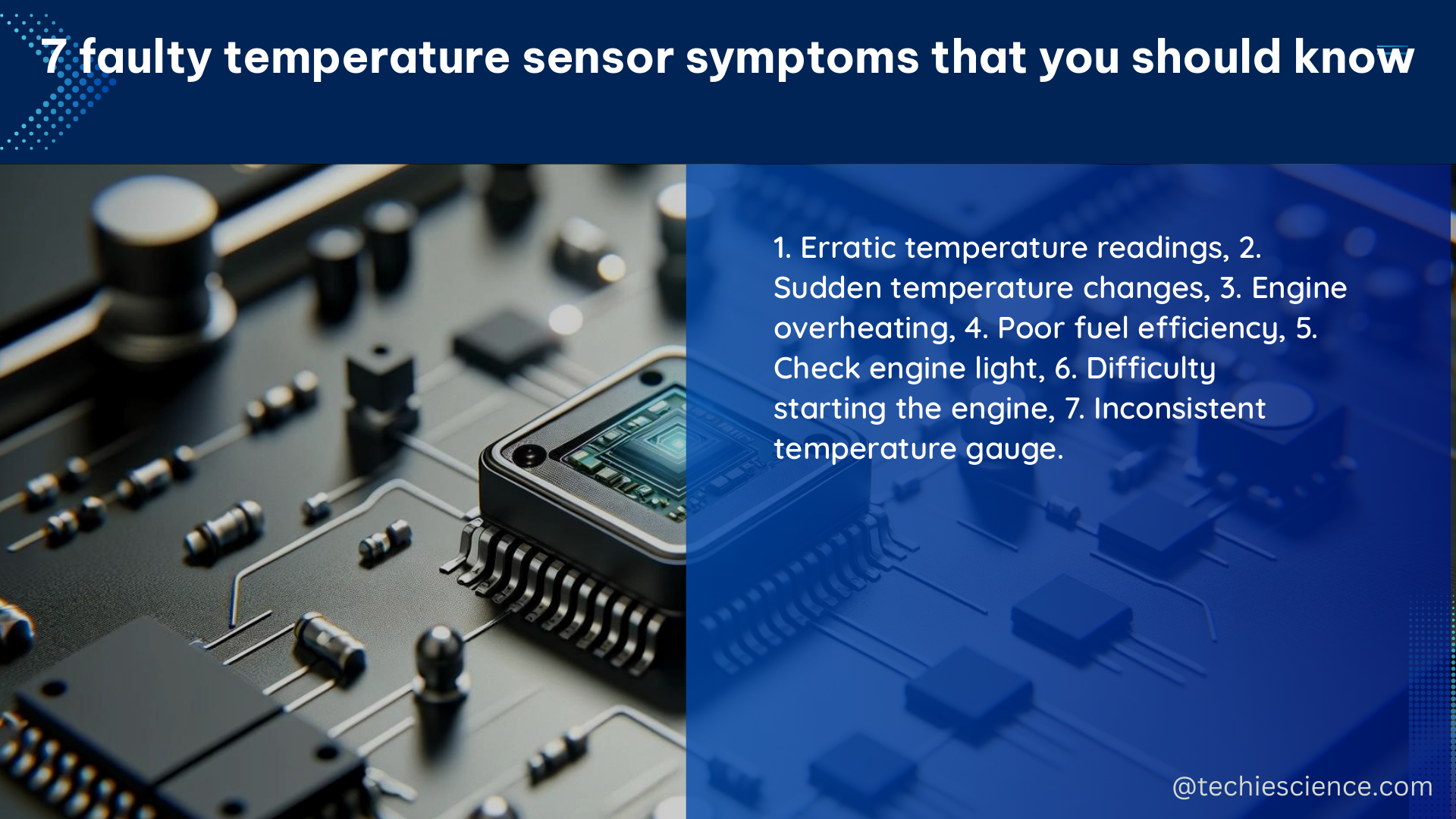A faulty temperature sensor can cause a wide range of issues in various systems, from inaccurate temperature readings to increased energy consumption and reduced system lifespan. Understanding the common symptoms of a faulty temperature sensor is crucial for maintaining the efficiency and longevity of your system. In this comprehensive guide, we’ll explore the technical specifications and a DIY approach to identifying these symptoms.
Inaccurate Temperature Readings
One of the most obvious signs of a faulty temperature sensor is inaccurate temperature readings. This can be caused by a variety of issues, including damaged wiring, a dirty sensor, or a faulty sensor itself. The degree of inaccuracy can vary, with some sensors providing readings that are off by as much as 5-10% or even several degrees Celsius/Fahrenheit.
To measure the accuracy of a temperature sensor, you can use a calibrated reference thermometer and compare the readings. If the sensor’s readings are consistently off by a significant amount, it may be time to replace the sensor.
System Instability

A faulty temperature sensor can also cause system instability, leading to frequent on/off cycling. This happens when the system constantly adjusts itself based on incorrect temperature readings, which can reduce the lifespan of the system and cause discomfort for users.
To monitor system instability, you can track the system’s temperature regulation over time. Look for instances where the temperature fluctuates rapidly or the system is constantly turning on and off, as these may be indicators of a faulty temperature sensor.
Overheating or Freezing
Another symptom of a faulty temperature sensor is the inability to detect when the system is overheating or freezing. This can be especially problematic in systems where temperature regulation is critical, such as HVAC systems or industrial machinery, as it can cause damage to the system and reduce its lifespan.
To detect this issue, monitor the system’s temperature regulation over time and look for instances where the temperature goes outside of the normal operating range. If the sensor is not accurately detecting these extreme temperatures, it may be faulty.
Increased Energy Consumption
A faulty temperature sensor can also cause the system to use more energy than necessary, as it may constantly adjust itself based on incorrect temperature readings. This can lead to increased energy bills and a reduced lifespan for the system.
To measure the impact of a faulty temperature sensor on energy consumption, track the system’s energy usage over time. Look for spikes or sustained increases in energy consumption that coincide with the suspected faulty sensor.
System Failure
In some cases, a faulty temperature sensor can cause the system to fail entirely. This can be caused by a variety of issues, including a complete failure of the sensor or a critical failure in the system’s temperature regulation.
To detect system failure, monitor the system’s performance over time and look for instances where it is not functioning properly. This could include the system shutting down unexpectedly, failing to maintain the desired temperature, or exhibiting other signs of malfunction.
Reduced System Lifespan
A faulty temperature sensor can also reduce the lifespan of the system, as it may cause the system to work harder than necessary or fail entirely. This can lead to costly repairs or replacements.
To assess the impact on system lifespan, monitor the system’s performance over time and look for instances where it is not functioning as efficiently as it should be. This could include increased wear and tear, more frequent breakdowns, or a shorter overall lifespan compared to the expected service life.
Increased Maintenance Costs
Finally, a faulty temperature sensor can lead to increased maintenance costs, as it may require more frequent repairs or replacements. This can be especially problematic in industrial settings, where downtime can be costly.
To track the impact on maintenance costs, monitor the system’s maintenance records over time and look for instances where repairs or replacements are more frequent than normal. This can help you identify if the temperature sensor is a recurring issue that is driving up maintenance expenses.
By understanding these 7 faulty temperature sensor symptoms, you can proactively identify and address issues before they lead to more significant problems. Remember to always use a calibrated reference thermometer and monitor the system’s performance over time to detect any potential sensor-related problems.
References:
– Sensor Fault Detection and Diagnosis: A Survey
– The MIQE Guidelines: Minimum Information for Publication of Quantitative Real-Time PCR Experiments
– OPTQM REVIEWER 1
– Check and change ABS sensor
– Data Cleaning and Data Preprocessing

The lambdageeks.com Core SME Team is a group of experienced subject matter experts from diverse scientific and technical fields including Physics, Chemistry, Technology,Electronics & Electrical Engineering, Automotive, Mechanical Engineering. Our team collaborates to create high-quality, well-researched articles on a wide range of science and technology topics for the lambdageeks.com website.
All Our Senior SME are having more than 7 Years of experience in the respective fields . They are either Working Industry Professionals or assocaited With different Universities. Refer Our Authors Page to get to know About our Core SMEs.